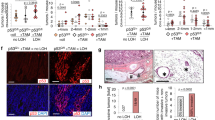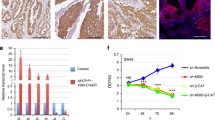Abstract
Wip1 phosphatase (PPM1D) has oncogenic properties and is implicated in a variety of cancer types, including gastrointestinal. Like Mdm2, Wip1 normally functions to resolve stress responses, such as after DNA damage, and return the cell to its normal, unstressed state. It is expressed in somatic as well as stem cells, with relatively high expression in intestinal stem cells. Loss of normal APC function and other events early in the carcinogenic process trigger a stress-like state often referred to as oncogenic stress. Wip1 can dampen protective responses to such stress through dephosphorylation of key activating sites in important tumor suppressors, such as p53. Even normal levels of Wip1 affect tumor suppression, because Wip1-deficient mice are markedly tumor resistant in a variety of tumor-prone models, including APCmin. Unlike Mdm2-null mice, Wip1-null mice have a relatively mild phenotype, so development of Wip1 inhibitors may be well tolerated in vivo.
Similar content being viewed by others
References and Recommended Reading
Jones S, Chen WD, Parmigiani G, et al.: Comparative lesion sequencing provides insights into tumor evolution. Proc Natl Acad Sci U S A 2008, 105:4283–4288.
Grady WM, Carethers JM: Genomic and epigenetic instability in colorectal cancer pathogenesis. Gastroenterology 2008, 135:1079–1099.
Lowe SW, Cepero E, Evan G: Intrinsic tumour suppression. Nature 2004, 432:307–315.
Bulavin DV, Fornace AJ Jr: p38 MAP kinase’s emerging role as a tumor suppressor. Adv Cancer Res 2004, 92:95–118.
Wood LD, Parsons DW, Jones S, et al.: The genomic landscapes of human breast and colorectal cancers. Science 2007, 318:1108–1113.
Kruse JP, Gu W: Modes of p53 regulation. Cell 2009, 137:609–622.
Fiscella M, Zhang H, Fan S, et al.: Wip1, a novel human protein phosphatase that is induced in response to ionizing radiation in a p53-dependent manner. Proc Natl Acad Sci U S A 1997, 94:6048–6053.
Clarke AR, Cummings MC, Harrison DJ: Interaction between murine germline mutations in p53 and APC predisposes to pancreatic neoplasia but not to increased intestinal malignancy. Oncogene 1995, 11:1913–1920.
Fazeli A, Steen RG, Dickinson SL, et al.: Effects of p53 mutations on apoptosis in mouse intestinal and human colonic adenomas. Proc Natl Acad Sci U S A 1997, 94:10199–10204.
Halberg RB, Katzung DS, Hoff PD, et al.: Tumorigenesis in the multiple intestinal neoplasia mouse: redundancy of negative regulators and specificity of modifiers. Proc Natl Acad Sci U S A 2000, 97:3461–3466.
Reed KR, Meniel VS, Marsh V, et al.: A limited role for p53 in modulating the immediate phenotype of Apc loss in the intestine. BMC Cancer 2008, 8:162.
Yamaguchi H, Durell SR, Feng H, et al.: Development of a substrate-based cyclic phosphopeptide inhibitor of protein phosphatase 2Cdelta, Wip1. Biochemistry 2006, 45:13193–13202.
Shreeram S, Demidov ON, Hee WK, et al.: Wip1 phosphatase modulates ATM-dependent signaling pathways. Mol Cell 2006, 23:757–764.
Demidov ON, Timofeev O, Lwin HN, et al.: Wip1 phosphatase regulates p53-dependent apoptosis of stem cells and tumorigenesis in the mouse intestine. Cell Stem Cell 2007, 1:180–190.
Chuman Y, Kurihashi W, Mizukami Y, et al.: PPM1D430, a novel alternative splicing variant of the human PPM1D, can dephosphorylate p53 and exhibits specific tissue expression. J Biochem 2009, 145:1–12.
Bulavin DV, Demidov ON, Saito S, et al.: Amplification of PPM1D in human tumors abrogates p53 tumor-suppressor activity. Nat Genet 2002, 31:210–215.
Takekawa M, Adachi M, Nakahata A, et al.: p53-inducible wip1 phosphatase mediates a negative feedback regulation of p38 MAPK-p53 signaling in response to UV radiation. EMBO J 2000, 19:6517–6526.
Lu X, Nguyen TA, Moon SH, et al.: The type 2C phosphatase Wip1: an oncogenic regulator of tumor suppressor and DNA damage response pathways. Cancer Metastasis Rev 2008, 27:123–135.
Lu X, Nguyen TA, Zhang X, et al.: The Wip1 phosphatase and Mdm2: cracking the “Wip” on p53 stability. Cell Cycle 2008, 7:164–168.
Chew J, Biswas S, Shreeram S, et al.: WIP1 phosphatase is a negative regulator of NF-kappaB signalling. Nat Cell Biol 2009, 11:659–666.
Lu X, Ma O, Nguyen TA, et al.: The Wip1 phosphatase acts as a gatekeeper in the p53-Mdm2 autoregulatory loop. Cancer Cell 2007, 12:342–354.
Li J, Yang Y, Peng Y, et al.: Oncogenic properties of PPM1D located within a breast cancer amplification epicenter at 17q23. Nat Genet 2002, 31:133–134.
Shreeram S, Hee WK, Demidov ON, et al.: Regulation of ATM/p53-dependent suppression of myc-induced lymphomas by Wip1 phosphatase. J Exp Med 2006, 203:2793–2799.
Bulavin DV, Saito S, Hollander MC, et al.: Phosphorylation of human p53 by p38 kinase coordinates N-terminal phosphorylation and apoptosis in response to UV radiation. EMBO J 1999, 18:6845–6854.
Fuku T, Semba S, Yutori H, et al.: Increased wild-type p53-induced phosphatase 1 (Wip1 or PPM1D) expression correlated with downregulation of checkpoint kinase 2 in human gastric carcinoma. Pathol Int 2007, 57:566–571.
Oshima T, Sasaki M, Kataoka H, et al.: Wip1 protects hydrogen peroxide-induced colonic epithelial barrier dysfunction. Cell Mol Life Sci 2007, 64:3139–3147.
Hartmann DP, Kallakury BVS, Luka J, et al.: Immunohistochemical expression of the PPM1D/wip-1 protein correlates with aggressive tumor behavior in invasive colorectal carcinomas (CRCS) [abstract 479]. Presented at the Annual Meeting of the United States and Canadian Academy of Pathology. San Antonio, TX; February 26–March 4, 2005.
Choi J, Nannenga B, Demidov ON, et al.: Mice deficient for the wild-type p53-induced phosphatase gene (Wip1) exhibit defects in reproductive organs, immune function, and cell cycle control. Mol Cell Biol 2002, 22:1094–1105.
Nannenga B, Lu X, Dumble M, et al.: Augmented cancer resistance and DNA damage response phenotypes in PPM1D null mice. Mol Carcinog 2006, 45:594–604.
Bulavin DV, Phillips C, Nannenga B, et al.: Inactivation of the Wip1 phosphatase inhibits mammary tumorigenesis through p38 MAPK-mediated activation of the p16(Ink4a)-p19(Arf) pathway. Nat Genet 2004, 36:343–350.
Potten CS, Ellis JR: Adult small intestinal stem cells: identification, location, characteristics, and clinical applications. Ernst Schering Res Found Workshop 2006, 81–98.
Morrison SJ, Kimble J: Asymmetric and symmetric stemcell divisions in development and cancer. Nature 2006, 441:1068–1074.
Bulavin DV, Kovalsky O, Hollander MC, et al.: Abrogation of oncogenic H-ras-induced cell-cycle arrest and p38 MAPK activation by disruption of Gadd45a. Mol Cell Biol 2003, 23:3859–3871.
Mendrysa SM, O’Leary KA, McElwee MK, et al.: Tumor suppression and normal aging in mice with constitutively high p53 activity. Genes Dev 2006, 20:16–21.
Qiu W, Carson-Walter EB, Kuan SF, et al.: PUMA suppresses intestinal tumorigenesis in mice. Cancer Res 2009, 69:4999–5006.
Ito K, Hirao A, Arai F, et al.: Reactive oxygen species act through p38 MAPK to limit the lifespan of hematopoietic stem cells. Nat Med 2006, 12:446–451.
Ventura JJ, Tenbaum S, Perdiguero E, et al.: p38alpha MAP kinase is essential in lung stem and progenitor cell proliferation and differentiation. Nat Genet 2007, 39:750–758.
Cha H, Wang X, Li H, Fornace AJ Jr: A functional role for p38 MAP kinase in modulating mitotic transit in the absence of stress. J Biol Chem 2007, 282:22984–22992.
Guo YL, Yang B: Altered cell adhesion and cell viability in a p38alpha mitogen-activated protein kinase-deficient mouse embryonic stem cell line. Stem Cells Dev 2006, 15:655–664.
Sharpless NE, DePinho RA: How stem cells age and why this makes us grow old. Nat Rev Mol Cell Biol 2007, 8:703–713.
Park IK, Qian D, Kiel M, et al.: Bmi-1 is required for maintenance of adult self-renewing haematopoietic stem cells. Nature 2003, 423:302–305.
Molofsky AV, Slutsky SG, Joseph NM, et al.: Increasing p16INK4a expression decreases forebrain progenitors and neurogenesis during ageing. Nature 2006, 443:448–452.
Lee JS, Lee MO, Moon BH, et al.: Senescent growth arrest in mesenchymal stem cells is bypassed by Wip1-mediated downregulation of intrinsic stress signaling pathways. Stem Cells 2009, 27:1963–1975.
Zhu YH, Zhang CW, Lu L, et al.: Wip1 regulates the generation of new neural cells in the adult olfactory bulb through p53-dependent cell cycle control. Stem Cells 2009, 27:1433–1442.
Wong ES, Le Guezennec X, Demidov ON, et al.: p38MAPK controls expression of multiple cell cycle inhibitors and islet proliferation with advancing age. Dev Cell 2009, 17:142–149.
Saito-Ohara F, Imoto I, Inoue J, et al.: PPM1D is a potential target for 17q gain in neuroblastoma. Cancer Res 2003, 63:1876–1883.
Belova GI, Demidov ON, Fornace AJ Jr, et al.: Chemical inhibition of Wip1 phosphatase contributes to suppression of tumorigenesis. Cancer Biol Ther 2005, 4:1154–1158.
Rayter S, Elliott R, Travers J, et al.: A chemical inhibitor of PPM1D that selectively kills cells overexpressing PPM1D. Oncogene 2008, 27:1036–1044.
Author information
Authors and Affiliations
Corresponding author
Rights and permissions
About this article
Cite this article
Demidov, O.N., Cha, H., Bulavin, D.V. et al. Wip1, an oncogene targeting tumor suppressors expressed in intestinal stem cells. Curr colorectal cancer rep 5, 197–202 (2009). https://doi.org/10.1007/s11888-009-0027-4
Published:
Issue Date:
DOI: https://doi.org/10.1007/s11888-009-0027-4




